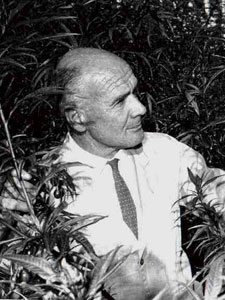In 1989 Rachel and I moved to Dunedin where I was to lecture in the Botany Department at the University of Otago. Here I met the retired former Professor of Botany Geoff Baylis for the first time. He generously let me use a bedsit at his George St house while we house hunted. This was one of two huge old houses Geoff owned and Alan Mark wrote in his biography of Geoff:
Geoff had many close friends and was renowned for his frequent hosting of parties. These were mostly at his spacious flat in the Victorian mansion, ‘Threave’, at 367 High St, originally designed (by famous architect R. A. Lawson) as a retirement home for early Central Otago run-holder Watson Shennan. He later bought, restored and maintained the several flats in this spacious house to a very high standard. Being an admirer of stately homes, he later also acquired and restored another at 521 George St, with its impressive garden fronting Dunedin’s main street. Geoff spent many of his outdoor hours in Dunedin, relaxing and engrossed, tending the gardens of both properties, with their remarkable range of native and exotic plants. Many of Geoff’s parties were preceded by garden tours, often at the guests’request. His house restoration efforts were duly recognised with an Historic Places award in 1979.
Rachel and I, along with our just beginning to walk son Nathaniel, were invited to dinner at ‘Threave’. A lasting memory is walking into the two storied vestibule of Threave with its massive wooden staircase and think our modest two bedroom bungalow would easily sit in this space. Geoff’s apartment was on the second floor and included the second floor of the two storied turret that dominated the south-west corner of the building and gave sweeping views across South Dunedin to the ocean. Here in the turret, he plied us with pink gins. The dinner was ham, salad and boiled potatoes and Rachel saying later it was a real bachelor’s dinner – something he did well and often. Geoff had dabbled in mycology his whole career and had hosted Egon Horak on one of his many trips to New Zealand to collect mushrooms. In a booklet created for the mycologist Barbara Segedin on her retirement from the University of Auckland Geoff contributed this:The cap must fit
When Egon and Marianne Horak were collecting in Otago they stayed with me, I showed Egon a little gasteromycete from tussock grassland for which I could find no name.
It duly became Nivatogastrium baylisianum.
On a class excursion I saw one and could not resist saying “That little fungus is named after me.” One of the girls was obviously puzzled but her frown cleared when she compared the little tan-coloured dome in the grass with my sunburnt bald head, “I can see the resemblance” she said.
Geoff’s pouch [Nivatogastrium baylisianum] has been an elusive species but recently has been recollected from the original collecting site in the Rock and Pillar Range in Otago [collected by Kathy Warburton and identified by Jerry Cooper]. No doubt there will be a name change as the molecular data unravels the true relationships of the pouch fungi [see my blog Pouch, secotioid, or sequestrate? and The scarlet roundhead]. There are four species in the genus Nivatogastrium. The type species Nivatogastrium nubigenum was described from North America whereas the other three species, including Nivatogastrium baylisianum, are all from New Zealand. Nivatogastrium nubigenum is closely related to the mushroom genus Pholiota and Jerry Cooper’s preliminary work suggests that Nivatogastrium baylisianum is closer to the mushroom genus Deconica. I’ll let you know the outcome.References
Horak E. 1971. Contributions to the Knowledge of the Agaricales s.l. (Fungi) of New Zealand. New Zealand Journal of Botany 9: 463-93. Link here
Mark A 2004. Geoffrey Thomas Sandford Baylis. 2004 Academy Yearbook, Academy of the Royal Society of New Zealand. Link here
Nature Watch New Zealand 2015. Discovery: critically rare fungus rediscovered. Link here

![Threave, High St Dunedin, 2011 [photo Geoff Ridley]](https://sporesmouldsandfungi.files.wordpress.com/2015/06/high-st-1.jpg?w=495&h=666)
![Threave, High St Dunedin, 2011 [photo Geoff Ridley]](https://sporesmouldsandfungi.files.wordpress.com/2015/06/high-st-2.jpg?w=740&h=523)
![Nivatogastrium baylisianum [from Horak 1971]](https://sporesmouldsandfungi.files.wordpress.com/2015/06/nivatogastrium.png?w=742&h=705)
![Nivatogastrium baylisianum [photo Kathy Warburton]](https://sporesmouldsandfungi.files.wordpress.com/2015/06/nivatogastrium-2.jpg?w=492&h=700)